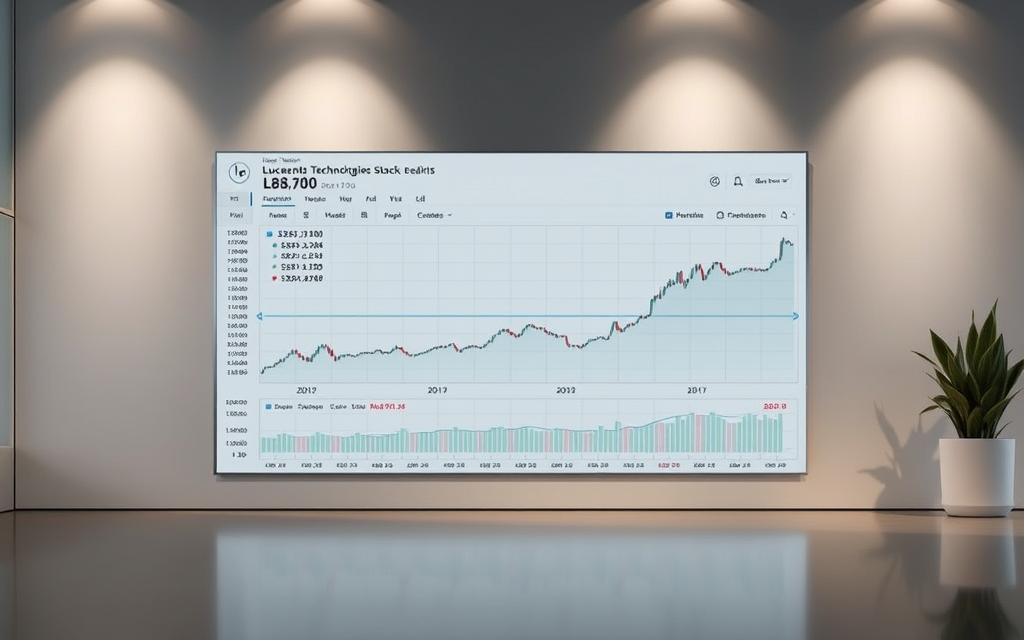Once a telecom giant, Lucent Technologies carved its place in history as an AT&T spin-off in 1996. The company quickly became a key player in the industry, known for innovation and market dominance.
By 2006, Lucent merged with Alcatel SA, marking the end of its independent trading. The stock symbol LU was delisted, closing a significant chapter in telecom evolution.
This article examines its financial journey—from the 1999 peak to the 2002 crash—and how the merger reshaped the sector. Understanding these shifts helps decode modern telecom trends.
What Is Lucent Technologies Stock Worth Today?
November 30, 2006, marked the final trade for Lucent’s stock under the symbol LU. The company merged with France’s Alcatel SA, forming Alcatel-Lucent and ending its independent trading. Shareholders received 0.1952 Alcatel American Depositary Shares (ADS) per Lucent share.
Why Trading Stopped
The $13.4 billion deal required approval from the Committee on Foreign Investment in the U.S. (CFIUS). Regulatory scrutiny delayed the merger by six months. By the year’s end, the combined entity faced challenges, including a 35% drop in price by 2008.
Merger Mechanics
Alcatel’s larger market cap dictated the share conversion ratio. Pre-merger, Lucent’s valuation lagged behind its French counterpart. The table below contrasts key metrics:
| Metric | Lucent (2006) | Alcatel (2006) |
|---|---|---|
| Market Cap | $9.1B | $13.4B |
| Revenue | $9.4B | $16.5B |
| Employees | 30,500 | 58,000 |
“The merger aimed to create a global telecom leader, but integration hurdles eroded value.”
Today, Nokia owns Lucent’s legacy assets after acquiring Alcatel-Lucent in 2016. Original shares are untraceable in modern stock exchanges.
The Rise and Fall of Lucent Technologies Stock
The late 1990s saw Lucent’s stock soar to unprecedented heights, fueled by the dot-com frenzy. Its journey from boom to bust reflects broader industry shifts and missteps.
Peak Performance: The 1999 Telecom Boom
December 1999 marked Lucent’s peak, with shares hitting a record price of $82.31. Revenue grew 20% that year, driven by insatiable demand for telecom equipment.
The dot-com bubble inflated valuations across the market. Lucent’s innovation in fiber optics and switching systems made it a darling of investors.
Lowest Point: The 2002 Market Crash
By October 2002, shares plunged to $0.58—a 99% drop from their peak. The wireline market collapsed, and accounting scandals eroded trust.
A $16 billion net loss in 2002 starkly contrasted with earlier success. The table below captures key declines:
| Metric | 1999 | 2002 |
|---|---|---|
| Share Price | $82.31 | $0.58 |
| Market Cap | $258B | $2B |
| Revenue | $38B | $12B |
“Lucent’s fall mirrored the telecom sector’s reckoning—overexpansion met reality.”
FCC policy changes and the rise of wireless further strained Lucent’s wireline-dependent model. Competitors like Nortel faced parallel collapses, underscoring systemic risks.
Key Factors Influencing Lucent’s Stock Value
Investors witnessed dramatic swings in Lucent’s valuation due to evolving telecom trends. Financial metrics and industry disruptions dictated its trajectory, from dot-com highs to merger-era lows.
Market Capitalization and Share Price Trends
Lucent’s market cap swung wildly, peaking at $258 billion in 1999 before crashing to $2 billion by 2002. The formula Share price × Outstanding shares revealed stark contrasts:
| Year | Share Price | Market Cap |
|---|---|---|
| 1999 | $82.31 | $258B |
| 2002 | $0.58 | $2B |
| 2006 | $2.54* | $9.1B |
*Pre-merger adjusted for Alcatel conversion.
Despite 2006 revenue challenges, Lucent traded at 2× revenues—a sign of optimism around its CDMA450 Vietnam expansion and Maxis broadband deployment in Malaysia.
Industry Shifts: From Wireline to Wireless
Wireline revenue dropped 60% from 1999–2006, while wireless contracts like SK Telecom’s optical network deal gained traction. Key pivots included:
- IPTV investments: The MiViewTV platform aimed to capture next-gen TV earnings.
- VoIP adoption: Legacy infrastructure demand dwindled as calls moved online.
- IMS trials: 116 trials across 24 customers signaled a shift to IP multimedia systems.
“Lucent’s late wireless push couldn’t offset wireline declines fast enough to satisfy Wall Street.”
By 2006, 70% of its business relied on fading technologies, while rival companies led in wireless innovation. This mismatch sealed its merger fate.
The Alcatel-Lucent Merger: A Turning Point
Corporate restructuring reached new heights when Alcatel acquired Lucent in 2006. This transatlantic deal created the fourth-largest telecom equipment provider globally, but integration hurdles quickly surfaced.
How the $13.4 Billion Deal Reshaped the Company
The merger triggered immediate changes across both organizations. Third-quarter reports revealed an 80% profit decline, forcing rapid cost-cutting measures.
Key transformations included:
- Workforce reductions: 10,000 positions eliminated within 18 months
- R&D consolidation: Bell Labs’ patent portfolio became the merged company‘s crown jewel
- Cultural clashes: French centralized decision-making conflicted with American divisional autonomy
Hedge funds played a surprising role, with 23% of shareholders initially opposing the terms. SEC filings show heated debates over the 0.1952 ADS conversion ratio.
Impact on Shareholders and Stock Valuation
Original Lucent investors faced compounded challenges. The new Alcatel-Lucent stock lost 35% value by 2008, erasing merger synergies.
Critical financial shifts occurred:
| Metric | 2006 (Pre-Merger) | 2013 (Post-Merger) |
|---|---|---|
| Share Price | $2.54 | $1.12 |
| Dividend Yield | 3.2% | 0% |
| R&D Spending | $2.1B | $1.4B |
“The merger failed to deliver promised efficiencies—wireless sector growth outpaced the combined entity’s capabilities.”
Despite these struggles, the business maintained critical infrastructure contracts. The 2006 year-end report highlighted retained clients like Verizon and France Telecom.
Lucent Technologies’ Legacy in the Telecom Industry
The telecom landscape still bears the imprint of Lucent’s innovations and missteps. Its journey from dominance to merger offers enduring lessons for companies navigating rapid technological change.
Pioneering Advances in Network Technology
Lucent pushed boundaries with CDMA2000 deployments across emerging markets. Vietnam’s CDMA450 network expansion in 2006 demonstrated its ability to deliver high-speed connectivity in challenging environments.
Bell Labs remained the crown jewel, producing Nobel-winning research. Many patents filed during Lucent’s era now underpin modern 5G infrastructure. The industry still benefits from these breakthroughs.
- IPTV leadership: MiViewTV platform anticipated today’s streaming services
- Wireless transition: Early work on VoIP and IMS systems
- Global partnerships: Contracts with Verizon and SK Telecom set standards
Corporate Strategy Lessons Learned
The company‘s collapse revealed critical governance flaws. A detailed analysis shows how short-term earnings focus eroded long-term stability.
Key missteps included:
| Challenge | Impact |
|---|---|
| Inventory mismanagement | 66% workforce reduction by 2001 |
| Accounting irregularities | $16B net loss in 2002 |
| Wireline dependence | Missed wireless revolution |
“Lucent’s story remains the ultimate cautionary tale about innovation without financial discipline.”
While competitors like Cisco adapted successfully, Lucent’s symbol LU ultimately marked the end of an era. Yet its technological contributions continue shaping global communications.
Conclusion
Nokia’s 2016 acquisition closed the final chapter on Lucent’s valuation saga. The stock journey—from its 1999 peak to the 2006 Alcatel merger—highlights the risks of slow market adaptation.
By the merger year, each Lucent share converted to 0.1952 Alcatel ADS at a price reflecting fading wireline dominance. Today, Nokia holds the legacy assets, making original shares untraceable.
Key takeaways for business leaders:
- Track legacy value through Alcatel-Lucent’s SEC filings or Nokia’s investor news
- Study Lucent’s wireline-to-wireless transition as a cautionary case
- Compare its 2002 crash to modern tech sector volatility
Telecom’s evolution continues, but Lucent’s story remains a pivotal lesson in disruptive eras.
FAQ
Why is Lucent Technologies stock no longer traded?
What was the peak value of Lucent stock?
How did the Alcatel-Lucent merger affect shareholders?
What caused Lucent’s stock to decline in 2002?
FAQ
Why is Lucent Technologies stock no longer traded?
The company merged with Alcatel in 2006, forming Alcatel-Lucent. This deal ended its independent trading on the NYSE under the symbol LU.
What was the peak value of Lucent stock?
During the 1999 telecom boom, shares surged to over , driven by high demand for networking equipment.
How did the Alcatel-Lucent merger affect shareholders?
Shareholders received Alcatel-Lucent stock in exchange. The .4 billion deal aimed to strengthen market position but faced integration challenges.
What caused Lucent’s stock to decline in 2002?
The dot-com crash and reduced telecom spending led to massive losses. Shares dropped below
FAQ
Why is Lucent Technologies stock no longer traded?
The company merged with Alcatel in 2006, forming Alcatel-Lucent. This deal ended its independent trading on the NYSE under the symbol LU.
What was the peak value of Lucent stock?
During the 1999 telecom boom, shares surged to over $84, driven by high demand for networking equipment.
How did the Alcatel-Lucent merger affect shareholders?
Shareholders received Alcatel-Lucent stock in exchange. The $13.4 billion deal aimed to strengthen market position but faced integration challenges.
What caused Lucent’s stock to decline in 2002?
The dot-com crash and reduced telecom spending led to massive losses. Shares dropped below $1, forcing restructuring.
Did Lucent Technologies influence modern telecom?
Yes. Its innovations in fiber optics and wireless tech laid groundwork for today’s high-speed networks.
Where can I find historical Lucent stock data?
Financial platforms like Yahoo Finance or Bloomberg provide archived pricing and earnings reports.
, forcing restructuring.
Did Lucent Technologies influence modern telecom?
Yes. Its innovations in fiber optics and wireless tech laid groundwork for today’s high-speed networks.
Where can I find historical Lucent stock data?
Financial platforms like Yahoo Finance or Bloomberg provide archived pricing and earnings reports.


















